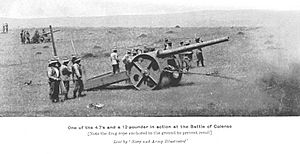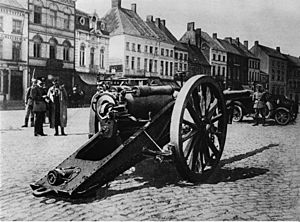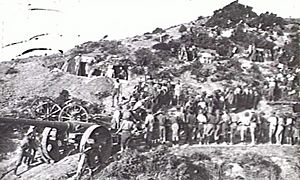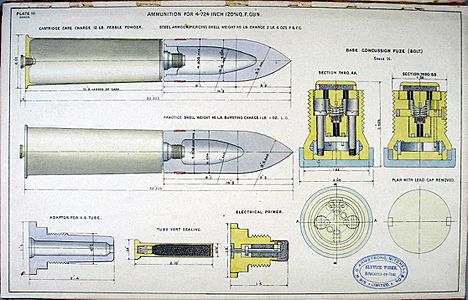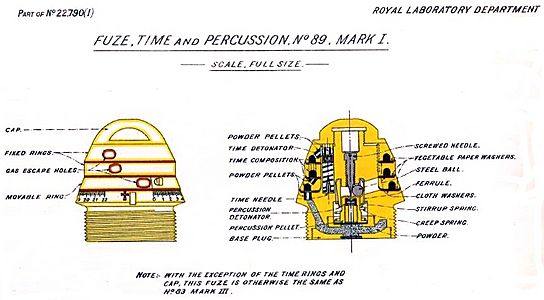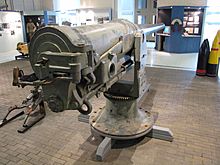QF 4.7-inch Mk I – IV naval gun facts for kids
Quick facts for kids QF 4.7-inch Gun Mk I – IV |
|
|---|---|
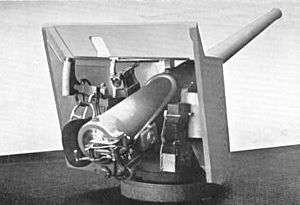
Typical naval deck mounting, 1890s
|
|
| Type | Naval gun Medium field gun Coastal defence gun |
| Place of origin | United Kingdom |
| Service history | |
| In service | 1887–1920 |
| Used by | Naval: United Kingdom Kingdom of Italy Field: United Kingdom United States Canada |
| Wars | First Sino-Japanese War Second Boer War World War I Italo-Turkish War Second Italo-Ethiopian War World War II |
| Production history | |
| Designer | Elswick Ordnance |
| Designed | ca. 1885 |
| Manufacturer | Elswick Ordnance Vickers Sons and Maxim |
| No. built | 1,167 |
| Variants | Mark I, II, III, IV, VI |
| Specifications | |
| Mass | Barrel & breech 4,592 lb (Mk I–III); 4,704 lb (Mk IV) |
| Barrel length | 189-inch bore (40 cal) |
| Crew | 10 |
|
|
|
| Shell | Separate loading QF; WWI : AP, Shrapnel, Common Lyddite, Common pointed, HE 45 pounds (20.41 kg) |
| Calibre | 4.724 inches (120 mm) |
| Breech | Single motion interrupted screw |
| Recoil | 12 inches (305 mm) (carriage Mk I) |
| Elevation | -6° – 20° (Mk I field carriage) |
| Traverse | 0° |
| Rate of fire | 5–6 rounds per minute |
| Muzzle velocity | Gunpowder : 1,786 feet per second (544 m/s) Cordite : 2,150 feet per second (660 m/s) |
| Maximum firing range | 10,000 yards (9,100 m) at 20°, 12,000 yards (11,000 m) at 24° |
The QF 4.7-inch Gun was a type of powerful British gun. It was designed in the late 1880s. "QF" stands for "Quick-Firing," meaning it could shoot very fast. These guns were used by many countries' navies (on ships) and armies (on land). They were important in several wars, including the Second Boer War and World War I.
This gun was made to replace older, slower guns. It used new types of gunpowder, like Cordite. This allowed it to fire much more quickly than older guns. Even though its shells were a bit lighter, its speed made it very effective.
Contents
Gun Design and How It Was Made
The QF 4.7-inch guns were designed by the Elswick Ordnance Company. This company was part of Armstrong Whitworth, a big British manufacturer. These guns were a popular item to sell to other countries. Because of this, they were actually 4.724 inches (120 mm) wide. This size fit the metric system used by many navies around the world. The British simply called it "4.7-inch" as an easy way to say it.
There were different versions of the gun, called Mark I, II, III, and IV. They all had slight differences in how they were built. The Mark IV was special because it used a "wire wound" design, which made it stronger.
British Military Use
British warships from the late 1800s, like pre-dreadnought battleships and cruisers, used these guns. The Royal Navy received hundreds of them. By World War I, these guns were considered old for warships. However, many were moved to merchant ships and troopships. They helped protect these ships from enemy submarines and other attackers.
British Army on Land
The British Army also used these guns on land. Some were set up as fixed coast artillery to defend shorelines. Others were put on special wheeled carriages. This allowed them to be moved and used as heavy field guns. These mobile guns were used by volunteer artillery units. Some even saw action in the early parts of the First World War.
Second Boer War (1899–1902)
During the Second Boer War, British forces faced powerful long-range guns from the Boers. To fight back, Captain Percy Scott from the ship HMS Terrible came up with a clever idea. He took two 4.7-inch guns from coastal defenses and put them on makeshift wooden stands. These were used during the Siege of Ladysmith.
Captain Scott then created a special "travelling carriage" for these guns. This allowed them to be moved by the army. These early carriages were simple and needed a lot of help to control the gun's kickback (recoil). They had to be tied to a strong point with a cable. Royal Navy sailors operated these guns, and it took up to 32 oxen to pull them!
First World War Battles
Fighting in South-West Africa (1914–1915)
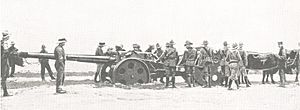
The same "Percy Scott" carriages were used by South African forces. They fought against German forces in the South-West Africa campaign during World War I. The guns were brought ashore and moved inland across the desert. They helped support the South African troops.
Western Front (1914–1917)
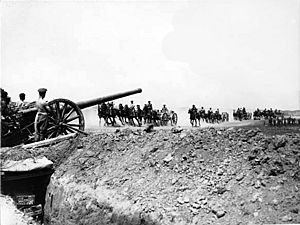
Many QF 4.7-inch guns were sent to France with British artillery units. They were mounted on more modern carriages that had some recoil control. These guns were important in early battles, like at Neuve Chapelle in March 1915.
However, as the war went on, the gun barrels became worn out from so much firing. This made them less accurate. Also, their shells were not heavy enough for the new style of trench warfare. Newer, more powerful guns like the 60-pounders began to replace them. The last 4.7-inch guns were removed from the Western Front by April 1917. They were then sent to other battle areas, such as Italy and Serbia.
Battle of Gallipoli (1915)
One 4.7-inch gun was used by Australian and Royal Marine forces at Gallipoli. It helped fight against long-range Turkish guns. An officer noted that they needed these guns to reach targets beyond the range of their smaller weapons. An old, worn-out gun arrived in July and fired its first shot later that month. This gun was later destroyed but was saved and is now in a museum.
Salonika Front
Several 4.7-inch guns on "Percy Scott" carriages were used by British and Serb forces. They served in the Salonika (Macedonian) campaign starting in January 1916.
Italian Military Use
In Italy, the QF 4.7-inch guns were known as 120/40 A 1889 and 120/40 A 1891. Italian companies made these guns under a special agreement. They were used on many types of Italian navy ships. These guns saw action in the Italo-Turkish War, World War I, Second Italo-Ethiopian War, and even World War II.
Japanese Military Use
First Sino-Japanese War
The Japanese cruiser Chiyoda, launched in 1890, was one of the first ships to use ten QF 4.7-inch Guns. After this, the Imperial Japanese Navy quickly added many quick-firing guns to their ships. In the Battle of the Yalu River (1894) in 1894, Japanese ships had a total of 60 QF 4.7-inch guns. This huge advantage in quick-firing guns helped the Japanese Fleet win the naval battle.
Japanese-Made Guns
Japan also made its own copies of the British Mark IV gun. They called it the Type 41 4.7-inch/40 (12 cm) naval gun. During World War I, the Japanese Navy sent some of these guns to Britain to help their Allies. Some of these guns were even used in British coastal defenses during World War II.
These guns were a standard weapon on most Japanese cruisers built between 1900 and 1920. They were also the main guns on some destroyers. Some were still in use as late as the Pacific War.
United States Military Use
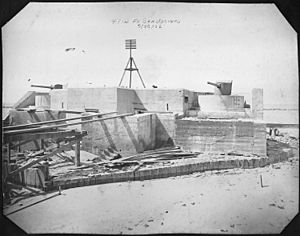
In 1898, the United States Army bought 35 British QF 4.7-inch guns. They were called "4.72-inch Armstrong guns." These guns were bought quickly because of the Spanish–American War. The US feared that the Spanish fleet might attack US East Coast ports. Most US defenses were old, so these new quick-firing guns were very important.
By the end of 1899, most of these guns were placed in forts along the East and Gulf Coasts. The US Navy also got two ships, the New Orleans and Albany, which had British-made 4.7-inch guns. These guns were later replaced with standard US Navy guns.
By 1913–1914, many 4.7-inch guns were moved or put into storage. Newer, more powerful 6-inch guns were taking their place. When the US entered World War I in 1917, some 4.7-inch guns were used again. Eight of them were loaned to the Army Transport Service to arm troop transport and cargo ships. After the war, all 4.7-inch guns were removed from service by 1920. Many were given to cities as war memorials.
Ammunition Used
The QF 4.7-inch gun used "fixed QF" ammunition. This means the shell and the gunpowder were loaded together as one piece. A complete round weighed about 45 pounds (20.4 kg).
The gun could fire different types of shells, including:
- Armor piercing shells (to go through thick armor)
- Common shells (for general use)
- High explosive (HE) shells (to cause a big explosion)
- Illumination shells (to light up an area at night)
- Shrapnel shells (which burst in the air and send out many small pieces)
Where to See Surviving Guns
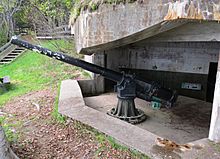
You can still see some of these historic guns today! Here are a few places:
- A 4.7-inch gun is displayed outdoors at Artillery Park in Valladolid, Spain.
- The burst gun barrel from Gallipoli is at the Australian War Memorial in Canberra.
- A naval gun is on display at the Museo Tecnico Navala Della Spezia, Italy.
- A Japanese-built 4.7"/40 Mark IV is in the Military Museum of Finland in Suomenlinna, Finland.
- One QF 4.7-inch Gun, Mark IV, made in 1894, is in the courtyard of the Indian Museum in Kolkata, India.
- Several QF 4.7-inch B Mk IV* guns are preserved at various forts in Canada, including Fort Amherst, St. John's, Bell Island, Fort Peninsula, and Fort Prevel in Quebec.
- Some US-used 4.7-inch guns are in places like Newport, Rhode Island; Sullivan's Island, South Carolina; Ansonia, Connecticut; and Danielsville, Georgia.
- Two 4.7-inch/50 calibre Mark 3 Armstrong guns from US Navy ships are at the Soldier and Sailor Monument in Geneva, Illinois.
Related Guns
- QF 4.7-inch Mk V naval gun – A slightly longer version of this gun.
- 4.7-inch gun M1906 – A US field gun of the same size.


